The process of setting up a wireless network
Network Administration - Now many of us probably know that, just a laptop that supports wireless access, you can sit anywhere in the coverage area of a hotspot. Wireless access to access the network. Indeed, the wireless network has given us a lot of choices in a company's network infrastructure. What is the process of setting up a wireless network basically? That is the topic in this article that we will introduce you to the process of setting up a wireless network.
Wireless network hardware
Setting up a wireless network is similar to setting up a wired network. However, the biggest difference lies in the hardware. In this section, we will introduce you to some of the most commonly used devices and explain their implementation functions.
Wireless access point
The central component of most wireless networks is the wireless access point, in which case you can refer to the 3Com model we took for example in Figure A below.
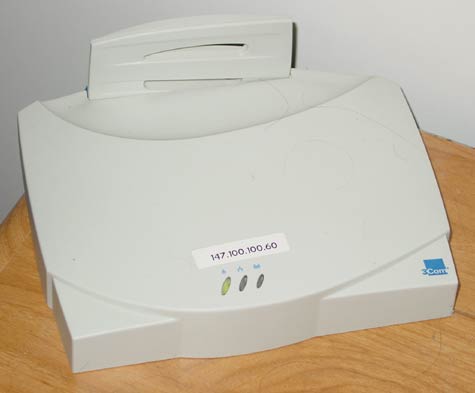
Figure A: 3Com wireless access point
The wireless access point is the device that connects a wireless network to a wired network. They function as a hub for wireless clients. The wireless access point also includes a standard Ethernet port for connecting to a wired network. This port allows two-way communication between two networks.
Although using an access point is the most used method in setting up a wireless network, it is not a requirement. You can use a wireless network card with two operating modes: infrastructure and ad hoc. When operating in ad hoc mode, the network card can communicate with each other directly without the need for an access point. However, using an access point makes your network easier to manage, allowing communication with wireless networks and giving you better control over security.
Gateway broadband
There are millions of different bands and models of wireless broadband gateway (for example, as shown in Figure B) on the market with many different features. However, they still have some common features: connect directly to your DSL or cable modem and share your broadband connection with wireless clients via a wireless access point. Most models also have an attached hub that can be used for wired clients. The most interesting thing about wireless broadband gateways is that most of them provide features that are only available to some large corporations for a certain number of years. In general, such products often cost between $ 200 and $ 600, depending on the features provided in them.
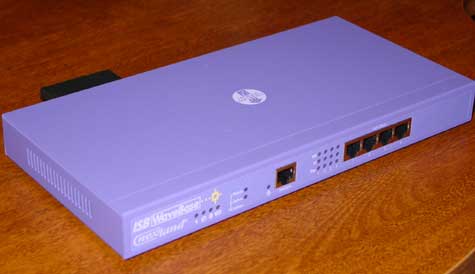
Figure B: An example of a wireless broadband gateway
Wireless PCI card
Laptops often use PCMCIA expansion cards, while workstations tend to use more PCI cards. However, both methods allow wireless network card support. Figure C below shows Linksys wireless PCI network card. Figure D is a PCMCIA card. The black component at the end of the card is the card's antenna. Both cards work at the same speed of 11 Mbps, but are used for different models.
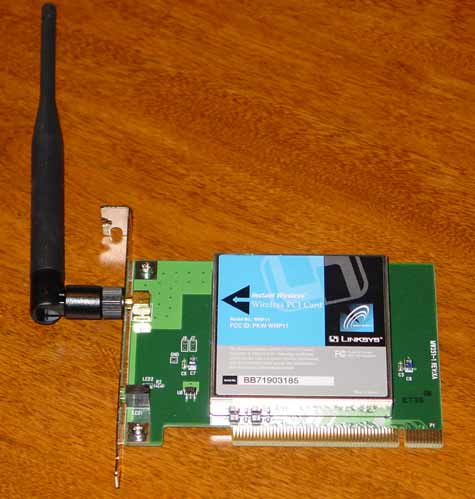
Figure C: Wireless PCI card
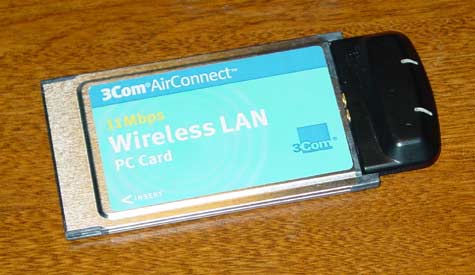
Figure D: PCMCIA card
Wireless USB NIC
Another type of wireless NIC is USB NIC. What's interesting about USB NICs is that they can work with both laptops and workstations. You can refer to the example of wireless USB NIC in Figure E below.
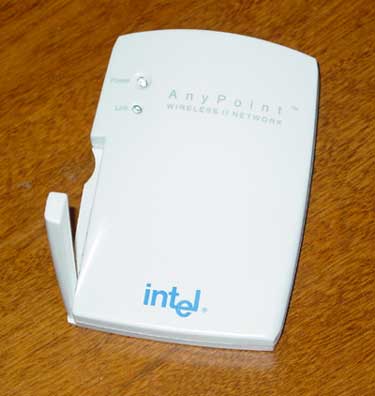
Figure E: Wireless USB NIC
Wireless Ethernet bridge provides connection between wireless network and wired network together. While the wireless access point allows wireless clients to connect to wired networks (and vice versa), the wireless Ethernet bridge allows wired devices to operate on a wireless network.
For example, one of the laser printers with an associated JetDirect card may allow direct plugging into the network. In this case you want to work on a wireless network but don't have a wireless card. The possible solution is to plug the printer's network card into an RJ-45 port on the wireless Ethernet bridge. In this situation, the printer will maintain its IP address as a bridge. When clients need to access the printer, routing tables will direct them through the wireless access point to reach the wireless bridge, then to the printer. In this scenario, you are using a wireless Ethernet bridge to connect a single device to a wireless network, but you can also connect a certain segment of the network to the wireless network through this bridge. However, if you plan to connect multiple devices, use a wireless access point to be more economical and efficient.
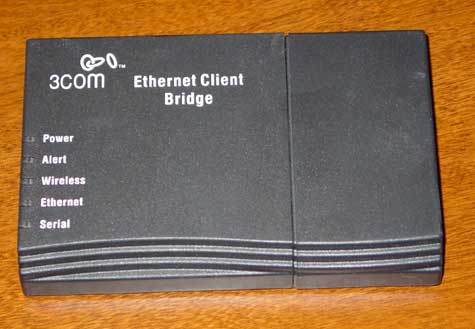
Figure F: Wireless Ethernet Bridge
Run wires for wireless
Normally, when you create a wireless network, you will have to start the process by connecting your access point to the wired network via a regular cable connection (not a crossover cable). When the wired connection to the access point is set up, you must use one of the wired network clients to configure the access point.
Web interface issues
Most wireless access points can be configured via the web interface. The blocks all come with a web server to manage a web configuration site. Similarly, blocks also have an attached DHCP server that can distribute IP addresses to wireless clients. If your network already has a DHCP server, then you should disable the wireless access point's DHCP server to prevent the filtering of IP addresses registered by another DHCP server.
Simply connecting to the wireless access point is easy, just open Internet Explorer, enter the IP address of the wireless access point. In this operation, you need to see the documentation that comes with the wireless access point to see which IP address is used, but the most commonly used address is 192.168.0.1. It may be difficult at first to connect to a wireless access point configuration site. However, if you encounter any problems, check to make sure that Internet Explorer is not configured to use a proxy server. If your network depends on the proxy server, then add an IP address of the wireless access point to the internal address table (LAT) of the proxy server, and you can access the configuration sie. No need to cancel client proxy client settings.
You may also encounter a subnet type error. For example, if your network uses a subnet mask of 255.255.0.0 and your wireless access point uses a subnet mask of 255.255.255.0, then your network will not be able to communicate with the wireless access point. In this case you can either put everything into a common subnet or update your routing tables to provide a logical path to the wireless access point.
Configuration
Once you have created a connection to the wireless access point's configuration page, start your process now. You must select the settings you want to use, then configure the wireless clients to use the same settings. The actual configuration process for a wireless access point varies depending on the device manufacturer, but the basic information you need to provide is exactly the same. In the sections below, we will introduce you to these important wireless settings.
Wireless LAN service area
The wireless LAN service area is still called the SSID, which is where wireless networks are verified. Typically, the wireless LAN service area is named in writing. For example, you can name your wireless LAN service area as some 'Wireless Company A'. Such a unique name will ensure that you are not mistakenly used next to the SSID.
Block name
Wireless access points are large enough to cater to most small offices. However, in large buildings, a wireless access point may not be enough to provide all the necessary coverage. In situations like this, it is necessary to use multiple wireless access points. In this way wireless network cards work similarly to cell phone phones. When a user roaming a building with a laptop, the wireless NIC will search for available access points currently provided with the largest signal and connect to this access point until the signal becomes weak. and need to replace with another access point. The name of the block is the method the wireless NIC uses to identify which access point it is communicating with.
Channels
Although 802.11B wireless access points work at the 2.4-GHz range, there are still different channels within the 2.4-GHz spectrum. Generally there are 9 channels available but some older models have only three to six channels. Setting up a wireless channel is as simple as adjusting the radio waves in a car to catch a certain broadcast station.
So why should there be so many channels? One reason is to help you find a path that is not affected by environmental factors. For example, when setting the number of channels to 3, wireless phones will affect network performance. Another reason for these channels is privacy. Imagine that you are operating on channel 6 but an office next to you also works with that channel. Usually, it will raise a problem here unless you choose to use the default SSID. If that happens, the two networks will interfere with each other.
Using different channels with each other together will give you better performance. Like copper cables, each channel has a limited amount of bandwidth. Typically, you must have up to 64 computers on a channel before the alarm performance, but if a client is using a heavy connection, performance degradation may occur with only a few. other online computers.
WEP
Wireless Encryption Protocol (WEP) is an encryption technology to prevent a third person from being able to hack into your channel to steal packets when they are broadcast on the air, besides their use. Allows you to increase access to sensitive information. WEP has several different coefficients: 40 bits (currently almost unused), 64 bits and 128 bits.
Enabling WEP is often a matter of choosing between 64-bit or 128-bit encryption and then selecting a password for WEP. The password for WEP must be a 13-character hexa number (for 64 bits) or 26 characters for (128 bits). The idea is that these numbers are not for transmission but for encryption on the access point configuration and client configuration. When a client sends a message to the access point, the packet is encrypted using the WEP password as a key. When the access point receives the message, it can decrypt it because the key is available.
You should read it
May be interested
- Upgrade wireless network system
 common universal wi-fi network is not chosen by enterprise (dn) as the main means of connection ...
common universal wi-fi network is not chosen by enterprise (dn) as the main means of connection ... - Wireless LAN security (Term 2)
 a wireless lan consists of three parts: wireless client, access points and access server. the typical wireless client is a laptop with a wireless nic (network interface card) installed to allow access to the wireless network. access points (ap) provide three
a wireless lan consists of three parts: wireless client, access points and access server. the typical wireless client is a laptop with a wireless nic (network interface card) installed to allow access to the wireless network. access points (ap) provide three - What is wireless charging? Is it faster or slower than charging?
 what is wireless charging? wireless charging is a type of charger that you don't need to plug the cable into the smartphone to charge it. simply place it on a special plate or stand to start the charging process.
what is wireless charging? wireless charging is a type of charger that you don't need to plug the cable into the smartphone to charge it. simply place it on a special plate or stand to start the charging process. - Several ways to improve Wi-Fi connection
 wi-fi wireless network is one of the biggest utilities of using a laptop instead of bulky desktops. instead of having to sit around all the time to keep away from the range of the network, you can carry your laptop across the room and still be able to surf the web comfortably.
wi-fi wireless network is one of the biggest utilities of using a laptop instead of bulky desktops. instead of having to sit around all the time to keep away from the range of the network, you can carry your laptop across the room and still be able to surf the web comfortably. - 4 tips for building better wireless networks
 how much performance do companies want to implement when they deploy a wireless network? these cases may not be enough - especially when wireless becomes a key part of the new data center infrastructure.
how much performance do companies want to implement when they deploy a wireless network? these cases may not be enough - especially when wireless becomes a key part of the new data center infrastructure. - Deploy WPA2-Enterprise wireless security in small businesses
 in this article we will show you some of the issues that are needed when setting up wpa2-enterprise wireless security.
in this article we will show you some of the issues that are needed when setting up wpa2-enterprise wireless security. - How to turn on / off automatically wireless network connection in Windows 10
 when you connect to a new wireless network, windows creates a profile for that wireless network. this guide will show you various ways to enable or disable the automatic connection to wireless networks in windows 10.
when you connect to a new wireless network, windows creates a profile for that wireless network. this guide will show you various ways to enable or disable the automatic connection to wireless networks in windows 10. - Upgrade wireless network security
 do you think the wireless network i am using is really safe? it is better to reconsider this issue. the latest wi-fi security standard, called wireless protected access 2 (wpa2), adds specialized data encryption capabilities.
do you think the wireless network i am using is really safe? it is better to reconsider this issue. the latest wi-fi security standard, called wireless protected access 2 (wpa2), adds specialized data encryption capabilities. - How to Change the Password to a Saved Wireless Network on a Windows Vista PC
 has your wireless network password recently changed and now you need to change it on your windows vista computer so you can connect to it again? read on from step 1 below to find out this process so you'll be on the road to reconnecting....
has your wireless network password recently changed and now you need to change it on your windows vista computer so you can connect to it again? read on from step 1 below to find out this process so you'll be on the road to reconnecting.... - Guide to DD-WRT - Part 2: Extending scope with WDS
 a wireless distribution system (wireless distribution system), is an economical and easy solution that can extend the coverage of wireless networks.
a wireless distribution system (wireless distribution system), is an economical and easy solution that can extend the coverage of wireless networks.










 Guide to building an Ultimate Wireless Network
Guide to building an Ultimate Wireless Network Set up your own home computer network
Set up your own home computer network Allows access to VMware Virtual Machine (NAT) from another computer
Allows access to VMware Virtual Machine (NAT) from another computer Configure the VMware VirtualCenter Management Server
Configure the VMware VirtualCenter Management Server Fix basic network applications with Wireshark (Ethereal)
Fix basic network applications with Wireshark (Ethereal) Configure TCP / IP to use DHCP and static IP address at the same time
Configure TCP / IP to use DHCP and static IP address at the same time